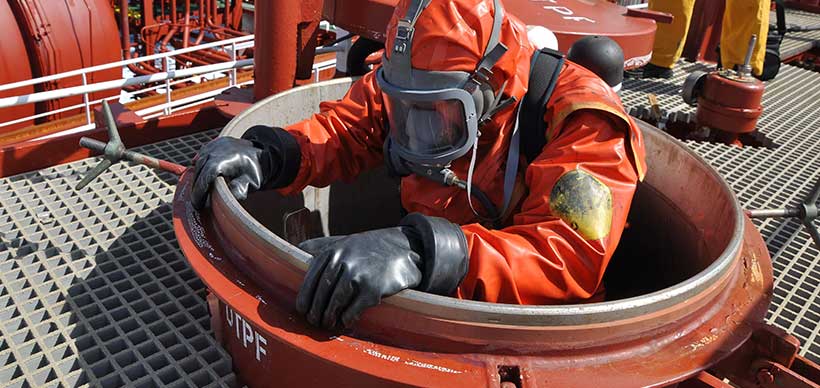Confined Space Rescue Procedures: 7 Steps That Can Save A Life
Confined Space Rescue Procedures: 7 Steps That Can Save A Life
April 11, 2023 |
When operating in confined spaces, it is essential for safety experts to contemplate what to do in case an individual gets hurt, incapacitated, or stuck and needs to be rescued. Here are seven steps for confined space rescue procedures that will assist safety experts in planning and executing a rescue from a confined space quickly and safely.
Undergo Professional Rescue Training and Practice Drills
Getting proper rescue training from professionals and conducting practice drills is one of the most effective ways to prepare for confined space rescue. Professional rescue training and practice drills allow employees to gain experience and become familiar with various scenarios that may arise in confined spaces. By conducting these drills, employees are better equipped to work well in confined spaces, protect themselves better, and rescue other workers in distress whenever needed.
Have a Professional Rescue Team Always on Standby
In numerous rescue scenarios, employees tend to assume that they can simply connect a co-worker to the winch line and pull without requiring an expert rescue team. However, this tactic may only be effective in cases where a worker falls straight to the bottommost of the confined space and remains still, which is a rare occurrence. Moreover, if there are multiple entrants, this strategy is not practical.
Therefore, employers must make sure that they have a highly-trained and well-equipped confined space rescue team always available to respond quickly when emergencies arise. Whether it is a small or large confined space, having a professional rescue team on standby and ready to act fast is crucial whenever a worker is hurt, stuck, or completely incapacitated.
Be Familiar with the Rescue Capabilities and Limits of Local Authorities
Relying solely on dialing 911 for confined space rescues isn’t always feasible, as authorities may lack the necessary resources or capabilities to execute such a rescue operation. Therefore, it’s imperative for safety professionals to be familiar with the rescue capacities and limits of the local authorities in order to establish rescue plans tailored to every unique circumstance. Should local authorities be unable to provide assistance, the safety professional must make necessary adjustments to make sure that the appropriate personnel or professional rescue team is readily available to respond to emergencies.
Evaluate the Confined Space Site and Layout Beforehand
The rescue plan may need to be altered by the safety professional based on the confined space site and layout. For instance, in the chemical industry, the conventional tripod utilized to pull employees out will not be practical in every confined space. Therefore, prior to any rescue operation, a thorough inspection should be conducted to determine the appropriate equipment and methods for operating within that specific confined space, as well as for effectively rescuing an employee during emergencies.
Assess the Confined Space Openings in Advance
In addition to inspecting the confined space site and layout beforehand, evaluating and examining its openings is also crucial. Many tend to assume that a rescue worker equipped with a breathing apparatus can easily fit into a confined space and maneuver without restrictions inside, but this is often untrue. Assessing the openings allows for an evaluation of the available space that employees and rescuers have for entering the confined space, as well as the different kinds of equipment they can bring inside with them.
Differentiate Between Time-Urgent Rescues and Non-Emergency Rescues
Knowing the difference between time-urgent and non-time-urgent rescues is crucial for safety professionals to plan and execute an effective response. Time-urgent rescues, also known as emergency rescues, are critical as they involve oxygen-depleted environments where there’s only a small timeframe, usually six minutes, to rescue the victim.
A non-time-urgent rescue scenario would be when a worker sustains a non-life-threatening injury, such as a broken ankle while entering a confined space. In such cases, there is enough oxygen in the space and so the non-emergency rescue can be carried out without the need for an additional oxygen supply.
Always Ensure Every Worker Dons a Full-Body Harness
The full-body harness is arguably the most vital piece of equipment used in confined space rescues. This is because to carry out rescues in confined spaces, it is often necessary to use lifting equipment that can be used to extract a hurt or incapacitated worker from the space. This winching equipment has to be attached to the employee’s full-body harness in order to lift the employee to safety.
Hence, full-body harnesses are indispensable for vertical rescues, where an employee needs to be winched up from a confined space, as well as horizontal rescues, where an employee needs to be placed on a stretcher and pulled up. If an employee forgets to don a full-body harness, rescues will turn into a far more challenging and time-consuming mission. In time-urgent rescues especially, rescuers simply cannot afford to waste time trying to put a full-body harness on an unresponsive person.
